A Curious Note
A few days after my article, “The Last Jew of Peki’in” was published on aish.com, I received an intriguing email.
Hi, Galia,
I am Ruth de Jong. I live with my husband, a Shoa survivor, next to the cave of Rashbi in old Peki’in. We’ve been taking care of the cave every day for years. Margalit Zinati is not the only Jewess in Peki’in. We too live in the village. . .
. . . I invite you to come to our place to hear the miraculous story how we came from Holland to Peki’in.
I immediately made arrangements to meet with Ruth and Abel de Jong to hear what would be one of the most remarkable accounts I’ve ever been privileged to hear.

A World of Unknowns
Ruth was raised in a Christian home in Holland. She was born in 1944, “the most bitter year of the Second World War,” she says. Her father was a Christian of German descent, although her paternal grandmother was Jewish. Her mother was non-religious, although she did give her baby a name that was unusual in Holland, especially during the war years: “Ruth.” “My mother was pregnant with me under German occupation,” Ruth says, “and she did a lot of gleaning in the harvest fields during the war, as Germans commandeered food from the Dutch for their own use.” The post-war years were not a propitious time to claim Jewish ancestry, and Ruth was raised with no knowledge of Judaism or Jewish ritual. Although she was very young, Ruth’s mother told her about the Jewish people and their fate in the War.
For some unexplainable reason, Ruth always felt drawn to Judaism and even took Hebrew language classes for 3 years. (Many years later she would convert to Judaism through Rabbi Shlomo Carlebach, who was living part-time in Israel.)
Ruth’s husband Abel de Jong, now 78, was born in Holland in 1940, the same year Germany invaded Holland. He was two years old when the deportations of Jews began.
Abel’s father, a physician, worked as a volunteer – – with a special permit to travel home – – in the modern hospital of the Dutch transit camp, Westerbork. “After a couple of months, he understood that the trains had a single destination: Auschwitz. But,” Ruth explains, “he simply had no idea what awaited the Jews upon their arrival there. He worked very hard to find medicines and food to ensure that sick Jews would be able to survive the journey to Auschwitz, never imagining that most of them would be murdered within 24 hours of their arrival there.” When it became clear that soon he, too, would be forced to join a transport, he decided the time had come to flee.
Abel’s parents were desperate to find a safe haven but thought their children would have a better chance of survival if they gave Abel and his infant brother Daniel to Dutch Christians. Meanwhile the parents hoped to escape to neutral Switzerland, from whence they would send for their sons.
Abel was given to a blue-collar childless couple who were religious Dutch Protestants. They treated him truly like a son. A few days before, the adoptive family’s patriarch, who lived a short distance away, had been caught harboring 5 Jews in his attic, and he was sent along with the 5 Jews he had hidden to Auschwitz, where he perished. So it was nothing less than heroic that the son and daughter-in-law of this murdered righteous gentile agreed to take a Jewish infant into their home and under their wing. They changed Abel’s name to a Dutch name, and never discussed his Jewish past, so he did not even realize he was Jewish, although in hindsight, Abel says, “I realized that I never felt fully comfortable by my new identity. I reclaimed my original Jewish first and last names as an adult.”
Abel’s baby brother Daniel was meanwhile thrust into the arms of another young Dutch Christian family, who wanted nothing to do with him due to the inherent danger in hiding anyone Jewish, especially a baby who was weak and ill. But Abel and Daniel’s mother made a big scene – – she was wailing hysterically – – and the man agreed to take Daniel temporarily, promising to place him with a different family, who were also childless.
A Failed Rescue
Meanwhile, in March 1943, Abel’s parents began their journey to freedom, traveling through Holland, Belgium, France, and eventually reaching Switzerland. There, they were caught by Swiss police, arrested as illegal aliens, and sent back over the border straight to German police in Occupied France. Ironically, had their small children accompanied them on their exodus to Switzerland, they would have been allowed to remain in Switzerland, since at that time the Swiss were willing to grant asylum to refugee families with children.
Once in Occupied France they somehow made it to Brussels, in Belgium. They paid a female guide to bring them over the Spanish border. The guide betrayed them, handing them over to the French police, who cooperated with the Nazis. They were taken to the French transit camp, Drancy, and from there they were transported, separately, to Auschwitz, where Abel’s mother died shortly after arrival.
A Tragic Fate
Arriving at Auschwitz in a cattle car, Dr. de Jong immediately recognized the smell of burning flesh, and realized that Auschwitz was no mere “work camp.” Due to his professional world renown – – according to colleagues of the de Jongs, he had been nominated for a Nobel Prize due to his work with vitamins, diet and nutrition – – he was of great interest to Josef Mengele, who made Dr. de Jong part of the evil Nazi doctor’s Jewish medical staff in Auschwitz. Abel’s father was himself an identical twin, and he was responsible for examining and cataloging Gypsy and Jewish twins, taking their measurements, weight, and conducted forced experiments with diets. He survived Auschwitz, but during the camp’s evacuation in January 1945 as Allied forces came closer, he was on a Death March, eventually reaching the satellite camp of KZ Mittelbau-Dora in the heart of Germany. He was killed there only days before liberation.
Until their final capture, both of Abel’s parents had been secretly able to send letters to their children at their adoptive families’ homes, which were miraculously hidden and preserved by the Dutch adoptive parents, and even more incredible, the parents were somehow able to exchange a few letters between one other, and through the underground these letters somehow made their way to Abel’s adopted family, where Abel saw them for the first time many years after the War after his true identity was made known to him.
Abel’s father’s twin brother was able to escape to England when the war broke out. There, he was a major figure in the Dutch resistance, and he served as the BBC’s Dutch broadcaster for the underground, where his news reports were transmitted to Holland. The Germans made it illegal for most Dutch citizens to own a radio, but Abel remembers his adoptive father holding him up to the radio in their home during an illegal broadcast, saying, “Listen to that man on the radio! He is your uncle!”
Life Begins Anew
After the War Abel’s uncle returned to Holland to recover his nephews from their adoptive families. But Abel could not adjust to his uncle’s family. He soon began to withdraw emotionally and physically. The trauma and upheaval were more than the little boy could take; and reluctantly, Abel’s uncle returned him to his adoptive Dutch family. His brother Daniel also remained with his adoptive Dutch family. Even though the boys were not far apart in age, they didn’t really relate to one another as brothers, despite their respective adoptive families’ efforts to ensure that they spent time with one another. This awkwardness would continue between them even in adulthood. Deep conversations were never successful, and most thoughts and feelings were left unsaid and unexpressed, although they often resorted to practical jokes and humor to communicate with one another.
As a young man, Abel was an iron worker, and fascinated by blacksmithing. In the neighborhood where he now lived in Leiden, there was a blacksmith with wonderful tools. Abel loved to engage the man in conversation, and learn more about the trade. It didn’t hurt that this man had a pretty daughter: Ruth. What was the likelihood that Ruth and Abel, both raised as non-Jews but secretly Jewish, would find one another on the same street in a Holland that was mostly devoid of its Jews? Today they’ve been married for more than 50 years and have four sons, one of whom lives in Israel with his wife and five children.
Meanwhile, they built their life together in the Netherlands. Abel was now working as a city planner and lawyer, and Ruth was a practitioner of alternative medicine, including acupuncture, psychotherapy, and classic homeopathy. They were very active, and both loved marathon biking trips across Europe. They began collecting antiques and Judaica, even though they still knew little about Judaism. Abel was especially drawn to a 200-year-old oil painting of a rabbi with a Hebrew inscription (which he could not read) in an old shop in Leiden, the Dutch city where he had grown up. He bought the painting and hung it in Ruth’s clinic in Holland. Little did they know how prominently this painting would figure in their lives in the coming years.

The Trial Aliyah
Ruth and Abel began to experience a vague disconnect with the Netherlands. Holland felt less like home, especially for Ruth after she visited Israel in 1964 and became enamored of that country. Israel was calling. In the 1980s, the couple decided to go to Israel for a two-year trial period, with the eventual goal of making aliyah.
They brought only their books, some clothes, Abel’s blacksmith tools, and the antique oil portrait of a rabbinical figure to whom, as the years passed, they felt very connected. Ruth was pregnant with her fourth child, Boaz.
They lived for a while in Moshav Amirim in the Galil, a vegetarian village. During her first weeks there, she had a terrible toothache and was advised to go to the new city of Karmiel to see a dentist. While awaiting her turn, she met a chassidic rebbetzin in the reception area by the name of Pesia Shtern. She and her husband were Breslov chassidim, and were caretakers of Rabbi Shimon bar Yochai’s burial cave in Meron. The rebbetzin was excited for Ruth about her upcoming birth, asked Ruth some questions, and wanted to know everything about her.
“When she found out that I was a natural practitioner, she became very excited and told me I must agree to treat the rebbetzin! So under her guidance I set up a bare-bones acupuncture clinic, and the rebbetzin became my first patient.” Ruth continues, “The ‘office’ had no furniture – – remember, we hadn’t brought our furniture to Israel from Holland. Abel had welded a frame together to make a bed, and a sheet covering the bed became the examining table.”
There was only one other item in the room: the portrait of the rabbi with its Hebrew inscription. When the rebbetzin entered the room, she gasped: “Where did you get this painting?! It’s the Rashbi! Rabbi Shimon bar Yochai! ” she cried. “Do you know where you’ve settled? This is the land of Rashbi!” The very rabbi and tzaddik whose grave the Shterns guarded and maintained!
Rabbi Shimon bar Yochai (the “Rashbi”)
Rabbi Shimon bar Yochai was a Talmudic sage who lived in Israel at the time of the destruction of the Second Temple. His teacher was the great Rabbi Akiva. The Romans had decreed it illegal to teach Torah, but Rabbi Shimon bar Yochai ignored the decree and was sentenced to death by the Romans for his defiance. He escaped their clutches after witnessing the tortuous death of martyred Rabbi Akiva, and hid out in various places in the Galilee, finally settling in a cave in Peki’in with his son Rabbi Elazar. Next to the cave is a spring and a giant carob tree, which sustained him for thirteen years. It is said that he and his son buried themselves naked up to their necks in sand to preserve their clothes, only putting them on once a week in honor of the Sabbath. And it was here that many Divine secrets of the universe were revealed to the Rashbi, and where the seeds of the Kabbala began. He authored the famous book of Kabbala, known as the Zohar.
Rebbetzin Shtern turned to Ruth, and said gravely, “You must be a shaliach (a person on a heaven-sent mission)!” Indeed, the Rashbi (the acronym for Rabbi Shimon bar Yochai) would figure greatly in Ruth’s life, in a series of signs and weird and wonderful events that could only be Divine Providence, only a few of which will be told in our story today.
Thanks to the Chassidic rebbetzin’s favorable recommendations, soon Ruth’s renown for healing the sick grew and people from all over Israel and abroad came to her acupuncture clinic for treatment. Meanwhile Abel was working as a welder in Ziv Hospital in Tzfat (since there were no jobs for lawyers with an expertise in Dutch law), and he decided to pay a visit to Rabbi Shtern in nearby Meron. Rabbi Shtern found lots of work for Abel, and he even started building mikvaos.
Ruth gave birth at home to her son Boaz. Rabbi Shtern arranged for a mohel to come to Moshav Amirim for the bris, along with hundreds of Breslover chassidim, all bearing food for a festive meal. Moshav Amirim is a secular moshav, and its residents didn’t quite know what had hit them! Suddenly their moshav was filled with dancing, singing Chassidim who had gathered around their secular neighbors – Ruth and Abel! The bris took place under the painting of Rabbi Shimon bar Yochai, on the “examining table” that Abel had made.
Life during their two “trial” years in Israel was good, but their eldest son, a teenager, was having serious difficulty adapting to Israeli culture, and really struggling psychologically and socially in high school. Before their trial period began they had made a pact that if any family member was terribly unhappy, they would return to Holland. With some regret, but for the sake of their son, they returned to the Netherlands at the end of the 2 1/2 years.
Back in Holland, Ruth was both busy and productive, and authored several books on a variety of topics. But Israel was still very much in her heart, and she found she could no longer tolerate life as a Jew in Holland. Her only escape from the ensuing depression she suffered was trips to Israel – – she visited every 3 months and continued her work as a therapist all over Israel. Her husband remained behind in Holland with the children. Each time she came to Israel, with her husband’s blessing, she visited different parts of the country, trying to find an apartment or house for them to buy, but nothing felt quite right.
Drawn to Peki’in
In 1999, Abel fell ill in Holland. Ruth advised him to recuperate in Israel, where they had a non-Jewish German friend who lived in Haifa and managed a conference center on Mt. Carmel. Abel stayed for a month, and while there he met a female Arab tourist guide from Peki’in, which is a primarily Druze village in the Galil with a long Jewish history. When she learned that Abel and his wife were looking to buy a house in Israel, she suggested that he visit the village. But in the 1990s public transportation by bus was extremely limited and Abel did not have a car. After a few tries, he gave up on trying to visit Peki’in. Feeling much improved, he returned to Holland. But shortly after his return, he received a birthday invitation to the German friend’s 50th birthday celebration in Haifa. Abel elected not to return to Israel to attend the party, due to work commitments, but Ruth had a strange feeling that she needed to be at that party, a feeling she could not logically explain.
And so she flew to Israel. At the party, a Christian Arab man approached her and began speaking to her in German. It turned out that his sister was the tour guide that Abel had spoken with about Peki’in, and who had invited him to visit. When Ruth asked about the house, the brother replied that very week, he and his 7 brothers had convened and decided to sell their aging parents’ house! Ruth became very excited and invited herself to go with him after the party to Peki’in. She spent the night at the house of his elderly mother.
The very next morning, the man came to his mother’s house to take Ruth on a scenic mountain drive of the area, and show Ruth around the town of Peki’in. They arrived at the center of Peki’in, where there is a large well fed by a spring. There was a map of the town affixed to a signpost, and the man pointed out the location of his mother’s home on the map in relation to the well. Next to his mother’s house on the map was a small star.
“What is the meaning of this star?” Ruth wanted to know.
“Next to the house is a cave under an old carob tree,” the Arab man replied. “This is where Rabbi Shimon bar Yochai hid from the Romans and where the wisdom of Kabbala was revealed to him!”
The Rashbi!
Divine Providence
Ruth felt chills. The man was asking an exorbitant price for what was essentially a ruin hanging precariously on a mountainside with a gorgeous view, a price that no sane villager would pay but an unsuspecting foreigner might. (Just how precariously it hung would become apparent a few years later.)
“We knew it was too much, but it was still cheaper than anything in Holland,” she confided, “and we had the money. A house next to the Rashbi! We didn’t understand it, but we knew there was something about this that was bigger than ourselves.”
They purchased the property from the Christian Arab, and slowly began renovations to make it livable. They still hadn’t returned to Israel permanently, but went back and forth from Holland to check on construction progress. At some point one of her sons lived in the unfinished house before moving elsewhere in Israel, as he had by then made aliyah. Only a few years later did she realize how their important their lack of permanence would be in introducing their presence to wary Christian and Druze neighbors, who were suspicious about Jews moving to Peki’in.
The Story of Peki’in
Historically, Peki’in was a Jewish village that existed at the time of the Second Temple. Six of the surviving twenty-four families of Kohanim (high priests) escaped to Peki’in from Jerusalem at the time of her destruction by the Romans. Margalit Zinati, from my article “The Last Jew of Peki’in,” is the only remaining surviving descendant of those 2000 year old families who still lives in the village today. Eventually early Christians, Muslims, and Druze came to live in Peki’in as well. But the road was a rocky one for the Jews, and they were driven out more than once by angry mobs.
The Druze are a mysterious people. They believe they are descendants of Yisro, the father-in-law of Moses. Their religion is secretive, and little is known about it by outsiders. There is no intermarriage allowed. Once a Druze marries “out” he is no longer considered a part of his people. Today there are Druze in northern Israel, Syria and Lebanon. As part of their creed, they follow the laws of the land. Hence, many Druze have served – – and died – – in the Israeli military on Israel’s behalf. They too have been a persecuted people, and as such are suspicious of outsiders. Because their religion and culture are so insular, they have little tolerance for outsiders who wish to “infiltrate” their living space. So when Jews started trickling back to Peki’in, it was more than the Druze could accept.
With their renovations complete and their youngest child now an adult, the de Jongs decided the time was right to return permanently to Israel. Their “second aliyah” was to their newly renovated home in Peki’in. After the news spread that Jews had bought a home in Peki’in, about 30 Jews settled in the village – – Jews whose goal it was to Judaize Peki’in once again.

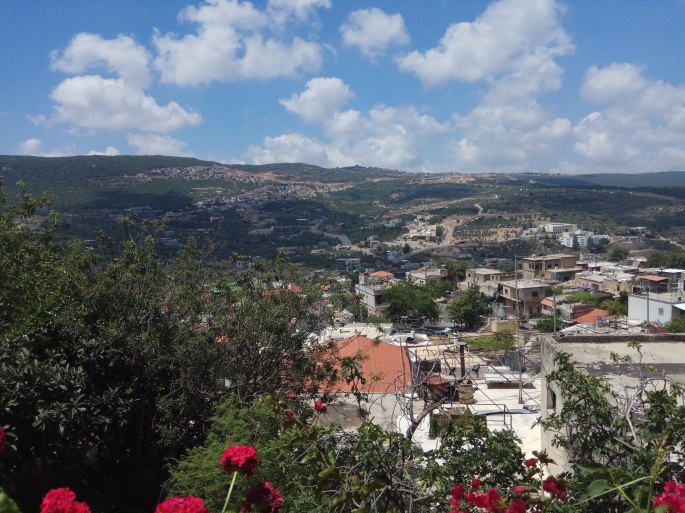



Troubled Times
But the pioneer spirit of reclaiming Jewish history came to naught. It all came crashing down, only a month after the de Jongs had moved permanently into their renovated home. Many of the 30 Jewish pioneers did not understand Arab culture and an Eastern mentality, and did not realize the extreme importance the Arabs attributed to codes of honor, respect, and the repercussions of losing face. Nor did the Jews understand the fear the Druze had of losing the land they had lived on for centuries.
One night the de Jongs awoke to the sound of gunfire. Suddenly there was shouting, yelling and cursing which could be heard echoing through the mountainside. And then there were gangs, then mobs, and then flames. “The entire village just . . . exploded,” Ruth said.
Mobs At Their Doorstep
Imagine the trauma and fear felt by the de Jongs, especially when their early life history is taken into consideration, as their house was surrounded by angry youth intent on violence. The de Jongs were defenseless. They had only large sticks, collected from the woodpile used for their fireplace, to protect themselves. It was only due to their neighbor, who chased the mobs away and warned them not to touch the de Jong’s property, that they were unharmed. Their car was burned to the ground. (It was replaced, only to once again be burned completely a few weeks later.) The thirty other Jews were now too afraid to remain in Peki’in, and left their burning houses.
“Police came to tell them that they could no longer protect us because of political reasons,” maintains Ruth. The de Jongs were forced to return to Holland. Six months later Abel and Ruth returned to Peki’in; their house was intact.
Thereafter, laws passed by the local council made it illegal for property in Peki’in to be sold to anyone who is non-Druze, and that law still stands today. Ever since then, the de Jongs have worked very hard to try to interpret the subtleties of cultural differences, and have cultivated amicable relationships with their immediate neighbors, both Christian and Druze. One elder, Abu Sutki, became very close with Abel, saying he felt as close to him as a beloved brother.

Eventually things calmed down. Perhaps because they are elderly and Dutch and it’s just the two of them living in the house, the de Jongs are not perceived as much of a threat. They maintain a cordial relationship with their Arab neighbors, and are sensitive to cultural and religious differences. They are resigned to living isolated from other Jews, because they are strongly committed to maintaining the Rashbi’s cave, and feel it is their destiny to do so.
The Earth Gives Way
One morning Ruth and Abel were awakened by a horrible crashing sound. She opened the door to her outside porch, and was startled to see . . . nothing! Part of the side of their mountain had suddenly fallen away, and the house continued to groan. They felt sure that the entire house they had restored so lovingly was in danger of immediate collapse.

Experts and structural engineers were called in. Because the house is precariously located, and surrounded by neighbors, there was no easy way for heavy construction equipment to access the house. A very complex solution to support the structure was recommended, but it meant tearing up years and years worth of landscaping work, trees and bushes and pathways. Instead, Ruth and Abel decided to tackle the challenge of repairing the structure themselves. At the age of 67 and 72, together they mixed cement, created wooden forms and framework, and placed lots of iron rebar alongside their mountain. Within only two months, they had created a 3-story cement retaining wall that is a true wonder!


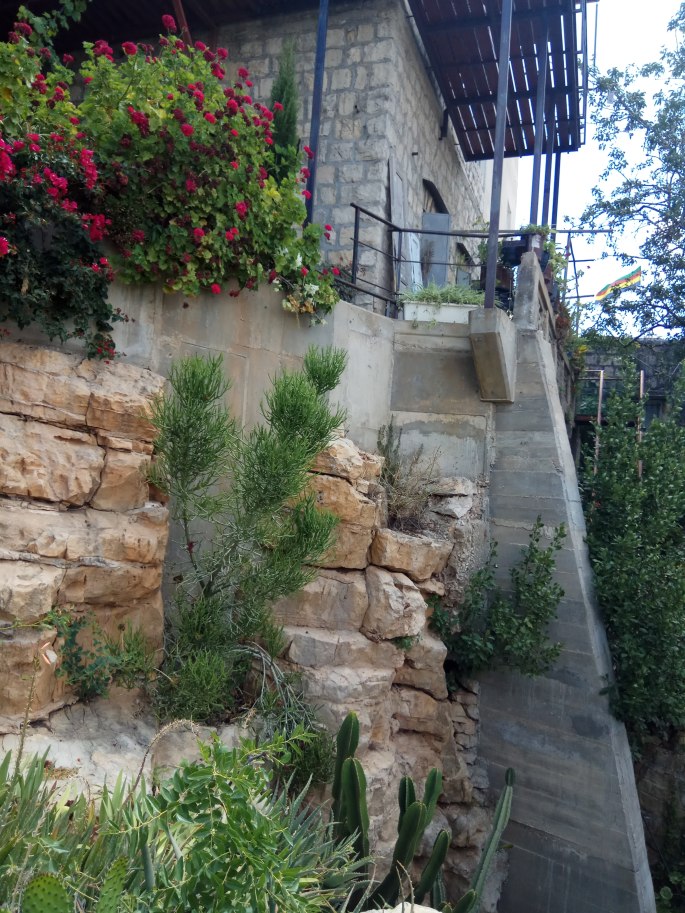
Although not officially trained in this capacity, Abel has tremendous talents for structural design and engineering, as well as implementation. This is only one example of the de Jong’s incredible self-sufficiency, independence and determination to remain in the place they love. They view their upkeep of the Rashbi’s tomb as nothing less than holy work.
Artifacts
Ruth took me on a tour of the house. Originally, a hundred years ago, the Druze in Peki’in were very poor, and their homes were constructed of mud and straw. When many surrounding villages were abandoned during Israel’s War of Independence, the Druze of Peki’in retrieved the building blocks from the rubble of the richer neighboring towns. When the de Jong’s house fell partially away, it was possible to see these layers of mud and straw and then stone blocks.

She also showed me a niche that was used for pita baking, and another stall which housed goats. In the old kitchen were utensils of copper and iron; on the wall was an antique Syrian scythe.
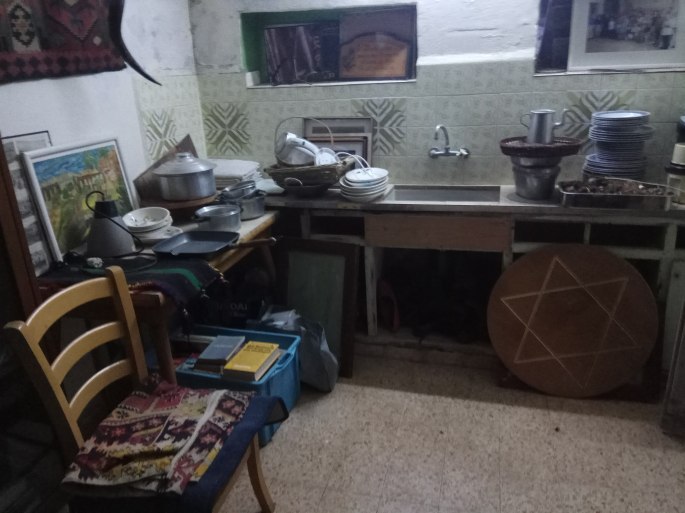


There was also a huge storage closet, called by the Turkish “keet,” where the previous family of 10 children stowed their sleeping pallets every morning, and pulled them out every evening at bedtime.

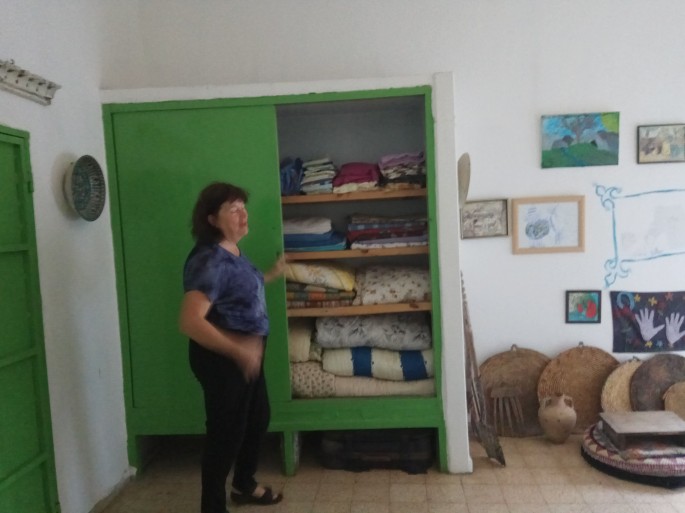
There were also the remains of a very old sledge, which had been used to separate grain and chaff; hand-woven baskets; and a round rattan disc that was used for kneading dough into pita and laffa.

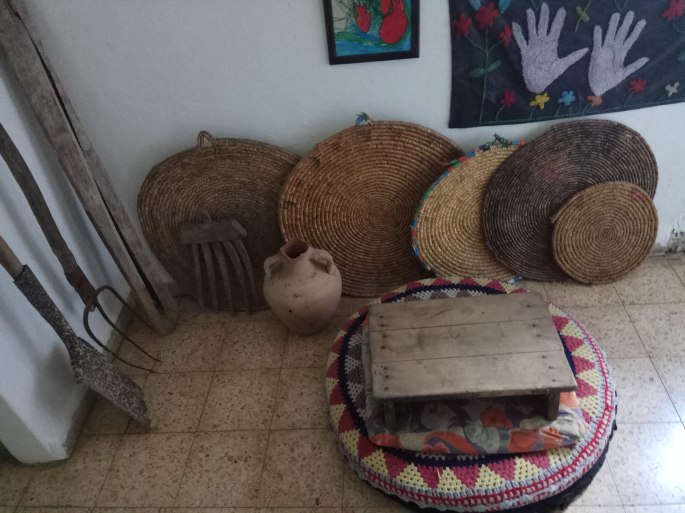
There were some amazing historical photos on the wall. Once while she was browsing through some antique books while on a trip to Holland, Ruth found a very old travel journal about the Middle East. She recognized one of the old sepia photos in the book: it was none other than Margalit Zinati’s father, in old Peki’in! (She bought the book and brought it to Israel.)


Abel used his blacksmithing talents to fix something for a Druze neighbor, and wouldn’t accept payment; his neighbor gave him an antique copper serving tray in exchange.

The de Jongs continue to collect unusual artifacts and old pieces of farming equipment and cooking utensils used by indigenous cultures.
The neighbors also enjoy sampling the literal fruits of the de Jongs’ labor: they grow figs, almonds, mulberries, herbs, and raise chickens who lay organic eggs.

The Memorial: Finding Peace
We continued walking along a lush, multilayered landscaped pathway. As we walked down narrow steps hand-built by Abel to the garden below, and finally to the cave of Rabbi Shimon bar Yochai, Ruth pointed out a young carob tree, with a small tag inscribed “Daniel.” This, too, had a story. Abel’s brother Daniel, who had never married, died a few years ago and was buried in Holland according to his wishes. The de Jongs wished to create a memorial for him. They planted the carob tree and placed a sign alongside it, inscribed with words about him.

The next morning, Ruth came to the spot to water the tree and noticed that the words on the plaque were gone. She couldn’t understand it, as there had been no rain to wash away the lettering. So that afternoon, she painted the letters on the sign so they would be more permanent.
The following morning, she again came to water the tree, and once again the letters were gone. She was both puzzled and disturbed. Deep in thought, she decided that it was Daniel’s way of telling them that he didn’t want the epitaph they had chosen. She let her eyes wander to the plants next to the tree, where she noticed a paper label on the ground, face down. She suddenly had a very powerful feeling that if she were to retrieve the label, her brother-in-law’s name would be on that label. To reach it she had to climb over the low fence, where the tree and label sat. When she picked up the label and turned it over, there was a picture of an Israeli flag with a Jewish star – – and the name “Daniel” printed on it! The de Jongs felt this was a Divine message, and encased the label in a simple plastic tag and tied it to the young carob sapling, where it remains today.
Hopes, Dreams and Prayers
Ruth walked with me to the Rashbi cave, bending down here and there to pick up stray litter and to sweep away errant leaves. At the mouth of the cave there was old wax from memorial candles and similar to the Kotel, a large collection of folded notes from many visitors, filled with prayers of hope and desperation, begging for salvation. I asked her what she did with the notes when they became too numerous for the narrow rock shelf and crevices in which the notes were placed.
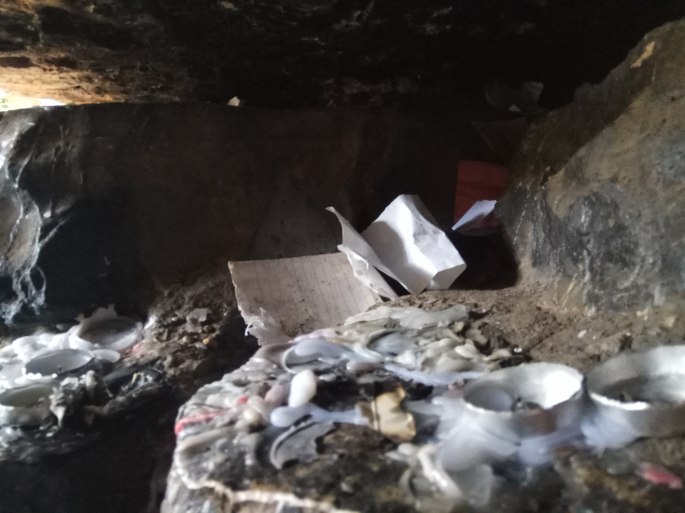
“I don’t touch them, nor do I read them,” Ruth says. “What’s interesting is that sometimes when people burn the candles, the intensity of the flames heats the rock shelf, and the papers either burn or dry up and disintegrate on their own. Then the remnants are carried away by the wind, perhaps to the heavens.
“I think that’s fitting,” she concluded, ” . . . don’t you?”


